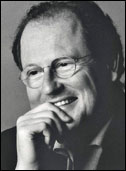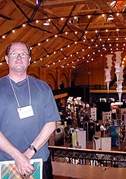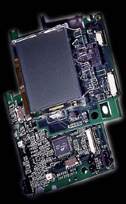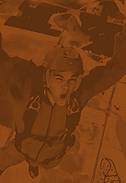|
Gianfranco Zaccai, co-founder of the international design consultancy Design Continuum, talked with Core jr. on August 17, 2001 in Boston, MA.
CJ: Tell us about your background as a product designer; where would you say you received your best
training for the profession?
GZ: My earliest and best training in product design (and life in general, of course) was from probably from my family: I was born in Trieste, Italy and we moved
to the U.S. when I was 9 years old. I went to Syracuse University, where
they have a great design program, initially for architecture, but then I found Industrial Design. Shortly after I graduated I returned
to Italy and worked back and forth for 13 years in the medical industry, which provided an excellent design education. At that time the medical
field was somewhat hostile to design, so I was forced to produce my own
engineering and produce designs that were really practical. I also
discovered that a lot of the briefs we were given from marketing weren't
based on any knowledge of what people were actually doing, but rather on
what the "experts" claimed they were. It gave me a healthy skepticism of
accepting something as you get it and beginning your work based on that
premise; I quickly learned the necessity of stepping back and doing my own
research.
Working in the cross cultural arena, both within a European and
American context, added to this. It let me see how the same reality
could be viewed differently, without being able to say that one view was
more valid than another, that there are legitimately different ways of
seeing the same thing. This highlighted the idea that there is a
cultural bias, even in areas that you might think are based on
scientific precision, like medical technology, there are things that are
emotionally driven, but must be taken into consideration in the process of creating a
viable new instrument.
In this environment I learned the most important lesson for all designers: Do your own research. Research results provided for you by the
scientists, technologists, market analysts, and so on, only cover a limited area. Only really getting in there, down and dirty, for yourself will let you see where people
are, what their aspirations are, and how this thing you create will
dovetail into all areas of their life.
CJ: Given your experiences with the medical industry, what do you think is a
designer's role in developing new uses for an overwhelming amount of new
technology, from genetic implants in our fingernails and DNA manipulation for our offspring, to biotechnology's solutions for food production? Any gut reactions?
GZ: He, he....My gut reaction is that you can't stop progress, but there should be
an attempt to herd it. Looking at these new ideas, they all have
various dimensions of problems, obviously there are ethical issues, but
beyond ethical considerations, there are the mechanical and logistical ones
that designers must deal with everyday. They have the opportunity to see what
the scientist and biotechnologist aren't seeing, there's always the
human dimension that design can add some value to, whether it's a value
based on creating accessibility or simply having a sensibility to people's desire or
ability to embrace new technology.
CJ: We've read that you attempt to create a holistic and integrated
design approach within your own company. How do you accomplish this, especially when dealing with designers so wedded an idea that risks being summarily shot down by the group?
GZ: You want to create a nurturing environment by developing and
recruiting people from different backgrounds and fields of expertise.
You want a dynamic that can respect each other's points of view, that
can augment each other's perspectives. A bad idea should be "shot down," but not just because it deals with an aspect of
problems that someone is not sensitive or sensible about, or provides a
level of inconvenience. You don't want to lose ideas simply because
they're presented on what's never a level playing field: in one
case the engineer has the upper hand, another time the marketing guy has
the upper hand, or maybe it's the designer with the upper hand. It's just
like "absolute power corrupts absolutely." So, you have to create a
level playing field where everybody has an equal level of authority.
Then, you have to get all those guys out of the studio and out of the
lab and out of whatever their own environment is and into real life. Get
them to develop a shared empathy for whatever the shared problem is.
We all have blind spots and need to be able to use other's backgrounds
and sensibilities to avoid being blindsided by them. We want people to
respect everyone's talents and creative serendipity and be able to use them together in the most
constructive sense.
CJ: At this point in your professional life how much and in what way are
you able to take part in actual design projects?
GZ: Well, not as much as I would like!
Actually, I'm very involved in designing concepts, or designing the
metaphors that explain the concepts, that are often outside a client's
purview. For a recent Smithsonian presentation, I used this as a vehicle for
talking about what I think are going to be some future trends in
opposition to the ways things've been going, particularly in the area of
technologies that solve individual problems, but at a collective burden.
My hypothesis is that the future is not going to look so much like what
we thought it'd be, rather, if we do it right, the future is going to
look and feel more like the past. Look at the technological increase in tools, appliances, personal
assistants, items for the home, and so forth. They provide tremendous
benefit, initially, but I think they reach a cusp where the benefits are
outweighed by the burdens they create.
Look at this in terms of communication aids: cell phones, wireless
internet, pagers; all provide a great boon to the need to be connected,
but, by now, we can never just disconnect. The ritual of work has to return to a more tangible and meaningful
experience, especially for people involved in intellectual occupations.
CJ: So you see the conceptual designer as one who can direct innovation
to avoid such burdens from developing?
GZ: I'm not sure if it's such a practical as an illustrative way. I like
to look at what's real and working and make connections to disparate
things to see what could be done better, right now in some cases, in the
near future in others. It means thinking longitudinally instead of
latitudinally.
Look at the problems presented by our need for food. There's the set of
issues with food preparation: so much convenience has been designed into
the way food is prepared, for people who have less time to actually
enjoy it, while the convenience of the food makes it less enjoyable in the first place. But, more important, is the need to nurture yourself and your
family. Food, obviously, is a big part of this, but there's something
about envisioning a way of living that's much more like the way we used
to live, even a million years ago. Then, we'd kill something, throw it
on the fire, huddle around, wait, tell stories, eat, throw the bones and
other garbage back in the flames, tell more stories; the fire provided more than
the heat to prepare the food to feed our biological needs, it also took
care of cleaning up the waste the meal created and provided the communal
meeting place to nurture our emotional and intellectual needs.
So, I see my role as one of breaking the typical trajectory: rather than
developing a new dishwasher that uses less water or energy, make a
system that provides for all parts of the ritual, from preparation to
cleaning, while encouraging us to spend even more of that quality time
with family and friends.
More and more there's the need to help define strategic
thinking and illustrate ideas that can make such innovations more viable
on the design front. My goal is to introduce, to the public design world, concepts that can become
real tangibles, innovating in ways that allow practical and emotionally-engaging, while financially feasible, ideas to see the light of day. All
too many crappy ideas see the light of day. We've ended up with this
corrosive quality of unchecked technology on our lives; the instruments
created to serve us have become our masters.
I can't get dressed in the morning without the cell phone. It has become
a burden. If I choose to dress without it, then I'm being rude by not
being accessible. If I choose not to answer it, then I'm being rude by
not responding. So, one solution becomes another problem and we must root
out a better answer. Maybe it's one of shape, maybe it shouldn't be a
phone at all, maybe it should be part of your wallet, or maybe it should have
different functionality, what response a caller receives, or something else entirely . . .
CJ: What's one of your designs that you're most proud of?
GZ: What I'm most proud of working on, or something I played at least a
dominant role in, is the Metaform Personal Hygiene System. I really
loved that project and all the various products that are a part of it.
Basically, we had a blank slate to research and come up with a system
that would allow people to remain independent in their own homes, with personal hygiene as the key area. We were able to do all kinds
of research on our own. One of the first things we discovered was that
it wasn't about ergonomics or making nice forms, but if you design
something expressly made for someone elderly or disabled, then they'll
try not to use it for as long as they can, since it stigmatizes them.
This makes for a very small market. So, we realized we needed to look at
the points of commonality between the very old and the very, very young.
In between are the people who may go out skiing, break a leg and also become
one of the users. We ended up with a cohesive group of products that
directly addressed the needs of all these people.
That was probably the most emotionally charged and satisfying project I
ever worked on, and also the most frustrating due to the fact that the
client backed out once they realized that they wouldn't have the resources to commercialize it,
being so far afield from their core business. Still, every week
someone tracks us down wanting to know how to get one.
CJ: Any hopes to bring it to production?
GZ: Well, there's always hope, but lately I've been more involved in
outreach and the realization of new paradigms of what products and
design services can do. I'm putting a lot of effort into designing an
environment internally that can address a wide variety of issues with an
appropriate cross-cultural, inter-disciplinary sensitivity. One thing
we've been pushing in our own offices is the personnel exchange program,
getting people out of their own cultural boundaries to develop the
sensibilities of other people and realties of other cultures. The way
people live their lives is 95% similar and 5% different. That 5% is
what's going to continue to engage us.
|
|

Gianfranco Zaccai

At the helm of the IDSA National Conference

Ever expanding medical design technology continues today at Continuum

A nurturing, supportive environment

Striking the hot lanes for design

Windows of design

A temporary solution for food preparation

A break from non-anthropomorphic strategies

A powerful master

A glimpse to true universal design
|